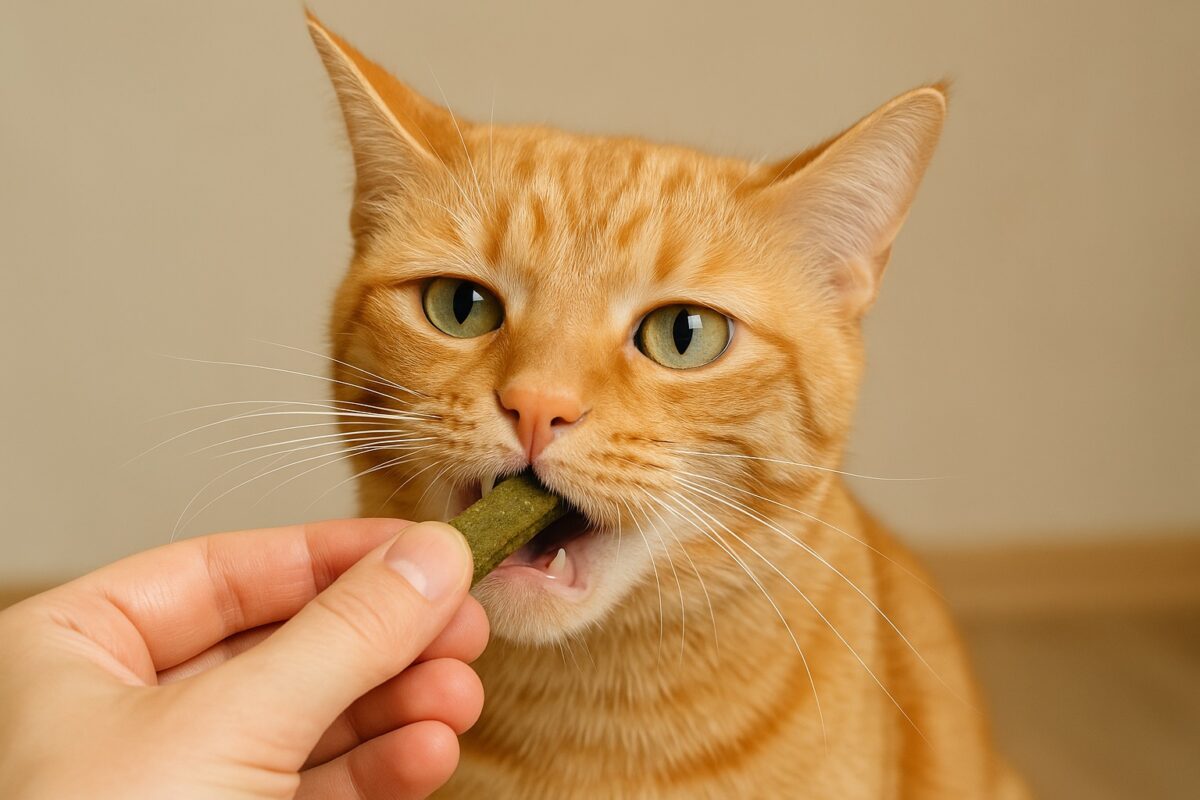Cat dental care is an essential part of overall pet wellness, yet it’s often overlooked by many pet parents. Unlike dogs, cats can be stealthy about their discomfort, and signs of dental issues—such as bad breath or reduced appetite—can go unnoticed until the problem becomes serious. That’s where dental treats can make a real difference. Choosing the best dental treats for cats helps maintain oral hygiene, prevent plaque buildup, and support long-term dental health.
But with hundreds of options lining pet store shelves and online marketplaces, how do you pick the right one? In this guide, we’ll walk you through everything you need to know about choosing the best cat dental treats for your furry friend—from understanding ingredients and benefits to recognizing what to avoid.
Why Are Dental Treats Important for Cats?
Dental treats do more than just freshen your cat’s breath. Here’s what they really offer:
- Reduce plaque and tartar: The texture of dental treats helps scrape off plaque before it hardens into tartar.
- Freshen breath: Many treats contain natural breath-freshening ingredients like parsley or chlorophyll.
- Encourage chewing: Some cats aren’t natural chewers. Dental treats can encourage this habit, which helps clean teeth.
- Support gum health: Ingredients like antioxidants and vitamins may reduce gum inflammation.
- Prevent dental disease: Over time, proper dental care reduces the risk of gingivitis, periodontitis, and tooth loss.
According to the American Veterinary Dental College, more than 70% of cats show signs of dental disease by age three. Choosing the best dental treats for cats can be a simple yet impactful way to support their health daily.
Key Features to Look For in the Best Cat Dental Treats
1. VOHC Seal of Approval
The Veterinary Oral Health Council (VOHC) is a trusted body that evaluates dental products for pets. Look for dental treats that carry the VOHC seal, as this indicates that they meet established standards for plaque and tartar control.
2. Texture and Shape
Treats should have a crunchy texture or specific shape that requires chewing. Soft treats may be tasty, but they often lack the abrasive quality needed to help clean teeth. Some dental chews are shaped to reach the back molars, where plaque tends to build up.
3. Healthy Ingredients
Quality matters. Look for treats with:
- Natural ingredients
- No artificial preservatives or dyes
- Added vitamins and minerals
- Digestive enzymes for oral and gut health
Avoid treats with excessive fillers, by-products, or sugar, which can harm dental and overall health.
4. Low Calorie Count
Dental treats should supplement your cat’s diet, not replace meals. Choose low-calorie options to avoid weight gain—especially important for indoor or less active cats.
5. Flavor and Palatability
Even the most beneficial dental treat won’t help if your cat won’t eat it. Popular flavors include chicken, salmon, and turkey. If your cat is a picky eater, look for sample-size packs or variety bundles to test different options.
How to Introduce Dental Treats to Your Cat
- Start Slow: Introduce new treats gradually to avoid upsetting your cat’s stomach.
- Use Positive Reinforcement: Give the treat after brushing or grooming to associate it with a positive experience.
- Be Consistent: Offer dental treats once or twice daily as part of your routine.
- Monitor Results: Check for improvements in breath, eating behavior, and gum color. If in doubt, consult your vet.
Top Recommended Brands Offering the Best Dental Treats for Cats
1. Greenies Feline Dental Treats
These are arguably the best dental treats for cats in terms of availability and popularity. They have the VOHC seal and come in various flavors like oven-roasted chicken and catnip. The crunchy texture helps clean teeth effectively.
2. Purina DentaLife Dental Cat Treats
Purina’s DentaLife is another VOHC-approved option with a porous texture designed to scrub teeth and clean hard-to-reach areas. They’re also low in calories, making them a guilt-free choice.
3. Virbac C.E.T. Intellident Cat Bites
Formulated by a veterinary dental care company, these treats offer triple-action benefits—cleaning teeth, freshening breath, and reducing tartar buildup. A strong contender among the best cat dental treats available through vets and specialty pet stores.
4. Emerald Pet Feline Dental Treats
These all-natural treats are grain-free, gluten-free, and soy-free—ideal for cats with dietary sensitivities. Their unique shape and texture promote chewing.
5. Hartz Dentist’s Best Dental Treats
Designed with proprietary DentaShield technology to block tartar formation, Hartz’s treats are a budget-friendly option for cat owners seeking daily oral care.
Common Mistakes to Avoid When Choosing Cat Dental Treats
- Ignoring ingredient lists: Steer clear of sugar, artificial flavoring, and excessive starch.
- Relying only on treats: While dental treats are beneficial, they shouldn’t replace brushing or regular vet checkups.
- Overfeeding: Always follow serving size guidelines. Treats should make up no more than 10% of your cat’s daily caloric intake.
- Assuming all treats are created equal: Not all marketed “dental treats” have scientific backing. Look for those with VOHC approval or clinical studies.
Complementing Dental Treats with a Full Dental Hygiene Plan
While the best cat dental treats can significantly support oral hygiene, they work best as part of a holistic dental care routine:
- Brushing: Use cat-safe toothbrushes and toothpaste at least 2–3 times a week.
- Dental rinses or water additives: These can further reduce plaque buildup and improve breath.
- Professional cleanings: Annual vet cleanings are essential, especially as your cat ages.
- Regular checkups: Keep an eye out for dental issues like red gums, drooling, or appetite changes.
Recent Research on Cat Dental Health (USA-Based)
A 2024 survey published by Pet Food Industry News found that over 63% of U.S. cat owners expressed concern about their pet’s dental health but only 22% actively use dental treats. Veterinary experts continue to stress the importance of early prevention through dental treats and brushing to reduce the cost and severity of future treatments.
Additionally, the American Veterinary Medical Association (AVMA) recently updated its dental care guidelines for pets in early 2025, emphasizing the daily use of dental chews or treats with proven efficacy.
Conclusion: Choose Smarter, Not Just Tastier
Selecting the best dental treats for cats isn’t just about flavor—it’s about function. These treats offer a convenient, affordable way to keep your cat’s mouth healthy while reducing the risk of long-term dental issues. Whether you’re dealing with a picky eater or a senior cat with sensitive teeth, there are options tailored to their needs.
Remember to look for VOHC approval, healthy ingredients, and a texture that promotes chewing. Combine treats with brushing and professional care, and you’ll be setting your feline friend up for a healthier, happier life.
Because a cat’s purr is better when it’s pain-free—and fresh-breathed.
FAQs
1. How often should I give my cat dental treats?
Once or twice daily, depending on the product’s instructions and your cat’s dietary needs.
2. Are dental treats a substitute for brushing?
No. They help reduce plaque and tartar but should be used alongside brushing and vet visits.
3. Can kittens have dental treats?
Most dental treats are for adult cats. Check the label to see if the product is safe for kittens over six months.
4. What if my cat won’t eat dental treats?
Try different flavors or textures. You might also consider water additives or dental gels.
5. Are there any side effects to dental treats?
If given in moderation and chosen wisely, side effects are rare. Overfeeding or poor-quality treats may cause digestive upset or weight gain.
Read more: Keeping Your Pet Safe During the Holiday Season: Essential Tips


